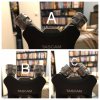GTBecker
Veteran
- Joined
- Jan 24, 2016
- Messages
- 125
- Karma
- 21
- Gear owned
- DR-44WL
> ... I would like to know what is best...
Well, there is no best unless you have also found worse and even worser. You must experiment - and, perhaps second only to listening to a pristine recording you've made, that's much of the fun.
You must experiment - and, perhaps second only to listening to a pristine recording you've made, that's much of the fun.
I had a DR-07 for a few months, but I never warmed up to either of its mic positions, coincident XY and spaced A-B. XY, at least at the 90° used in Tascams, doesn't provide sufficient separation for my preference although its convenience makes it handy to capture candid sound. And the DR-07's A-B spacing of ~3" was also too small for my taste. Of course, you might hear things differently, and the MKII version might behave differently.
I've found that I prefer wider angling and wider spacing so I often use ORTF, which is just a French version of A-B with 110° angling and 17cm (~6.5") spacing of cardioids. Of course, that means using external mics and appropriate mounting and cabling. Achieving an ORTF configuration with pencil mics requires some creative mount manipulation, too, I've found; the mic barrels or XRLs want to bang into each other.
You might consider upgrading to four channels, too, where you can use the XY pair of a DR-44WL and two additional cardioids on either side of center. If the recorder is, say, 20' back from the stage, try placing the side mics five feet or so to each side of center.
I also like MS but, with a bidirectional mic and a cardioid, even more mount work is needed. Still, the advantage of post-recording separation adjustment is satisfying.
Elevate everything, too.
What concert band are you able to record?
Well, there is no best unless you have also found worse and even worser.
I had a DR-07 for a few months, but I never warmed up to either of its mic positions, coincident XY and spaced A-B. XY, at least at the 90° used in Tascams, doesn't provide sufficient separation for my preference although its convenience makes it handy to capture candid sound. And the DR-07's A-B spacing of ~3" was also too small for my taste. Of course, you might hear things differently, and the MKII version might behave differently.
I've found that I prefer wider angling and wider spacing so I often use ORTF, which is just a French version of A-B with 110° angling and 17cm (~6.5") spacing of cardioids. Of course, that means using external mics and appropriate mounting and cabling. Achieving an ORTF configuration with pencil mics requires some creative mount manipulation, too, I've found; the mic barrels or XRLs want to bang into each other.
You might consider upgrading to four channels, too, where you can use the XY pair of a DR-44WL and two additional cardioids on either side of center. If the recorder is, say, 20' back from the stage, try placing the side mics five feet or so to each side of center.
I also like MS but, with a bidirectional mic and a cardioid, even more mount work is needed. Still, the advantage of post-recording separation adjustment is satisfying.
Elevate everything, too.
What concert band are you able to record?
Last edited:


